The Asia Pacific nutraceutical market is expected to expand steadily from USD 103.0 billion in 2025 to USD 202.6 billion by 2035, advancing at a CAGR of 7.0%. This growth reflects increasing consumer interest in health-conscious products, growing adoption of dietary supplements, and expanding applications across functional foods, personal care, and nutraceutical formulations.
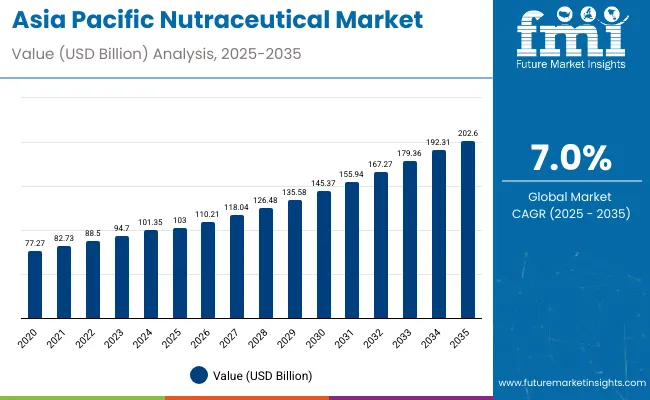
| Metric | Value |
|---|---|
| Estimated Value in 2025 (E) | USD 103.0 billion |
| Forecast Value in 2035 (F) | USD 202.6 billion |
| Forecast CAGR (2025 to 2035) | 7.0% |
The market demonstrates a consistent upward trajectory, driven by rising awareness of wellness benefits, a preference for natural and clean-label products, and fortified supplement variants appealing to health-conscious consumers throughout the region.
By 2030, the market is forecasted to reach USD 149.5 billion, reflecting steady growth through the first half of the decade. The absolute dollar growth between 2025 and 2035 is expected to be around USD 99.7 billion, indicating robust and reliable expansion. Market growth is considered back-loaded, with greater adoption of nutraceutical products in dietary supplements, functional foods, and personal care anticipated in the latter half of the timeline.
Leading companies such as Herbalife International of America Inc., General Mills Inc., PepsiCo Inc., Abbott Nutrition, and Amway Corp (Alticor) are consolidating their positions by expanding product portfolios and investing in innovative formulations. Their focus includes high-quality extracts, plant-based ingredients, and fortified health supplements, enabling stronger penetration into health-conscious and premium consumer segments.
The market holds a significant position in the dietary supplements sector, capturing more than 49% of the market share due to its essential role in supporting natural health and wellness across the region. This sector contributes substantially to the broader nutraceuticals market, driven by increasing demand for plant-based, science-backed health ingredients. The market also plays a growing role in functional food formulations and personal care products, reflecting its versatility and expanding applications.
The market is evolving with advancements in extraction and formulation technologies that enhance product purity and efficacy. Companies are expanding their portfolios with fortified and specialty nutraceutical products, including gluten-free and organic variants. Strategic partnerships with healthcare brands, retailers, and online supplement platforms are broadening market reach and reshaping distribution channels, positioning key ingredients as preferred components in natural health and premium dietary supplements across Asia Pacific.
The Asia Pacific nutraceutical market is growing due to increasing consumer demand for natural, plant-based health supplements that support overall wellness and chronic disease management. Rising awareness of health benefits from dietary supplements, functional foods, and personal care products is boosting adoption. Advances in extraction and formulation technologies improve product purity and efficacy, enhancing consumer trust and satisfaction. Growing trends towards clean-label, organic, gluten-free, and fortified supplements are further expanding market reach.
Key market players are innovating with high-quality, science-backed ingredients and expanding distribution through partnerships with healthcare brands, retailers, and online platforms. Sustainable sourcing practices and regulatory compliance also play crucial roles in shaping competitive dynamics.
Overall, the Asia Pacific nutraceutical market benefits from evolving health and wellness trends, technological advancements, and increasing disposable incomes, leading to strong and sustained growth across the region.
The Asia Pacific nutraceutical market is segmented by type, application, and country. By type, the market is divided into functional food, dietary supplements, pharmaceuticals, functional beverages, and personal care. Based on application, the market is categorized into general wellness, weight management, sports & energy, beauty and anti-aging, digestive health. In terms of country, the market is classified into China, India, Japan, Australia, Singapore, Malaysia, and New Zealand.
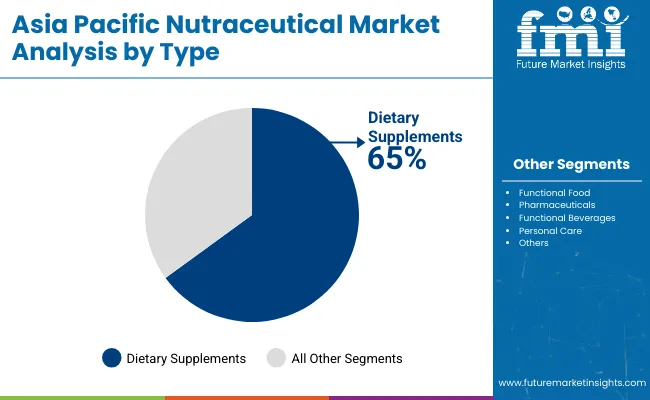
Dietary supplements emerge as the most lucrative segment, commanding 65% of the market share by type. This segment's dominance is driven by a growing consumer emphasis on preventive health care and managing chronic diseases, including cardiovascular conditions, diabetes, and nutritional deficiencies that are prevalent in the region. Dietary supplements encompass a broad array of products such as vitamins, minerals, herbal extracts, and protein-based supplements, catering to diverse health needs and demographics, from aging populations to fitness enthusiasts.
The rising middle-class population, increasing health awareness, and growing disposable incomes in key markets like China, India, and Japan further propel demand. Additionally, regulatory advancements facilitating easier market entry and product approvals contribute to supplement proliferation. Innovation in formulation and delivery forms such as gummies, powders, and plant-based proteins enhance consumer appeal and drive adoption. In contrast, other segments like functional food, pharmaceuticals, functional beverages, and personal care, while growing, hold smaller market shares but offer promising niches for future expansion.
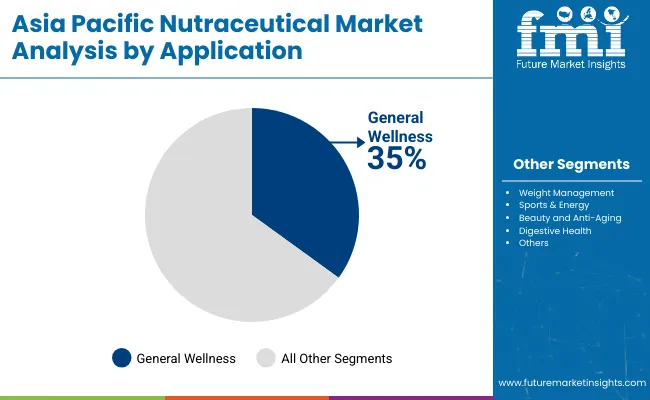
General wellness is the most lucrative application segment, holding 35% market share, driven by rising health awareness and demand for immune-boosting products. Weight management and sports & energy follow as fast-growing sectors propelled by fitness trends and lifestyle disease concerns. Beauty and anti-aging, along with digestive health, are emerging niches responding to growing consumer interest in appearance and gut health.
This diverse application landscape reflects the market’s ability to address a wide range of consumer health needs, supported by increasing disposable incomes, urbanization, and innovation in nutraceutical formulations. With the Asia Pacific region experiencing shifts towards preventive healthcare and natural health solutions, these application segments are poised for sustained growth, contributing significantly to the region's overall nutraceutical market expansion at an estimated CAGR of around 7% between 2025 and 2035.
From 2025 to 2035, the market is propelled by growing consumer demand for natural, plant-based health supplements. Increasing preference for high-quality, clean-label, and sustainably sourced nutraceutical products encourages manufacturers to invest in advanced extraction and formulation technologies. This evolution aligns with rising health consciousness and the need for preventive care across diverse populations in the region. Innovation in product development enhances efficacy and safety, particularly in cardiovascular and general wellness supplements.
Health Awareness and Cardiovascular Focus Boost Market Growth
Consumer health awareness, particularly focused on cardiovascular health and cholesterol management, acts as a major growth catalyst in the Asia Pacific nutraceutical market. Policosanol supplements, valued for supporting heart health, align well with preventive healthcare trends in the region. Improved extraction and formulation technologies elevate product efficacy and safety, meeting consumer expectations.
The rising use of clean-label and plant-derived ingredients reinforces the dietary supplement segment’s dominant market position. The increasing shift toward natural health solutions ensures continued demand growth, driving manufacturers to diversify product offerings and tap into the expanding pool of health-conscious consumers.
Innovation and Sustainability Expanding Market Opportunities
Innovation in product development is expanding the Asia Pacific nutraceutical market’s opportunities beyond traditional segments. Advances in formulation technologies include gluten-free, fortified, and sustainable supplements that improve bioavailability and shelf life. These innovations attract consumers seeking personalized and effective health solutions.
Companies embracing sustainable sourcing, strict quality certifications, and eco-friendly packaging appeal to the environmentally conscious demographic prevalent in Asia Pacific. The focus on sustainability and continuous product diversification across nutraceutical, dietary supplements, and personal care categories ensures long-term market growth and enhances competitive advantages in a dynamically evolving region.
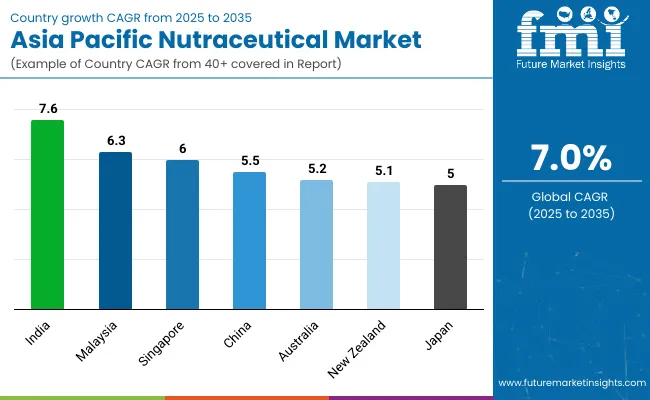
| Countries | CAGR (%) |
|---|---|
| India | 7.6% |
| Malaysia | 6.3% |
| Singapore | 6.0% |
| China | 5.5% |
| Australia | 5.2% |
| New Zealand | 5.1% |
| Japan | 5.0% |
The market exhibits varied growth rates across key countries, reflecting diverse market maturity and consumer dynamics. India leads the region with a robust CAGR of 7.6%, driven by rapid urbanization, rising income levels, and increasing health awareness. China's market grows at 5.5%, fueled by extensive government support and a large middle class embracing preventive healthcare.
Malaysia follows closely with a 6.3% CAGR, benefiting from an expanding middle class and rising wellness consciousness. Singapore, at 6.0% CAGR, thrives on premium product adoption and sophisticated regulatory frameworks. Australia and Japan display more mature markets with steady growth at 5.2% and 5.0% respectively, sustained by aging populations and stringent regulations promoting high-quality products. New Zealand, with a CAGR of 5.1%, emphasizes organic and natural product preferences.
Demand for nutraceutical in India leads with a CAGR of 7.6%, driven by urbanization, rising incomes, and expanding health awareness. Broad pharmacy networks augment distribution, while regulatory support favors herbal and Ayurvedic supplements. Lifestyle diseases are increasing, raising demand for dietary supplements. E-commerce growth expands reach across urban and rural populations. Preventive healthcare adoption is rising rapidly. Local manufacturers focus on R&D and marketing collaborations. Young and middle-class consumers show evolving consumption patterns, prompting innovation in product formulations and accessible pricing.
Revenue from nutraceutical in Malaysia grows at a CAGR of 6.3%, driven by an expanding middle class and evolving lifestyles. Demand increases for immunity and digestive health supplements due to heightened wellness awareness. Local manufacturing capacity enhancement improves product quality. Regulatory oversight strengthens consumer confidence. Urbanization enhances product access and consumption. Rising incomes and digital adoption spur market expansion. Health education initiatives promote natural supplement benefits. Manufacturer collaborations support credibility and product outreach.
Revenue from nutraceutical in Singapore is projected to grow at a CAGR of 6.0%, buoyed by a health-conscious, affluent population. The market excels in anti-aging and beauty supplements. A sophisticated regulatory environment fosters innovation and product differentiation. Functional beverages and supplement consumption are rapidly increasing. Expansion of health-focused retail chains and online sales platforms widen consumer access. Singapore serves as a logistic hub for the region, facilitating distribution. Collaborations between local and international companies support market penetration. Consumers favor advanced, science-backed products aligned with premium lifestyle trends.
Revenue fromnutraceutical in China is growing at a CAGR of 5.5%. China leads the region with over 49% of the market share, driven by increasing health awareness and significant government support for wellness initiatives. Rapid urbanization enhances demand for dietary supplements, while expanding e-commerce platforms increase consumer access. The rising middle-class population is embracing preventive healthcare, fueling market expansion. Domestic and international nutraceutical manufacturers invest heavily in innovative production technologies and product formulations, including integration of traditional medicine. Regulatory reforms streamline product approvals, accelerating market entry. Sustainability-focused production and packaging appeal to eco-conscious consumers, solidifying China’s dominance.
Revenue from nutraceuticals in Australia is expanding at a CAGR of 5.2%, driven by well-informed consumers and stringent regulations. Demand is strong for plant-based, clean-label products supported by sustainability trends. Pharmacists act as key influencers in supplement recommendations. Fitness and wellness culture spur growth in functional foods and beverages. Product safety and quality control maintain consumer confidence. Natural and organic formulations gain market share. E-commerce and health-focused specialty stores increase accessibility. Government initiatives promote awareness of natural supplement benefits.
Sales of nutraceuticals in New Zealand maintain steady growth at a CAGR of 5.1%, driven by strong consumer preference for organic and natural supplements. A developed retail infrastructure ensures broad product availability. Government health initiatives support preventive care adoption. The wellness and sports nutrition segments contribute robustly to growth. Sustainability and eco-friendly manufacturing appeal to conscientious consumers. Digital health platforms facilitate personalized consumer engagement. The mature, health-conscious demographic helps sustain market momentum, supported by continued innovation in natural formulations.
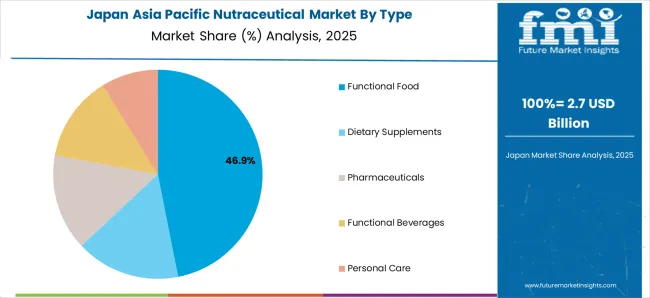
Revenue from nutraceuticals in Japan is growing steadily at a CAGR of 5.0%, supported by an aging population and high healthcare spending. Demand focuses on supplements for cognitive health and mobility. Strict regulatory framework ensures product quality and consumer trust. Wellness centers and fitness clubs enhance supplement adoption, strengthened by advancements in digital health compliance tools. Consumers prefer science-backed and premium nutraceuticals. Sustainable sourcing and organic certifications gain traction. Innovations include convenient dosage forms targeting aging-related health needs. Japan’s mature market offers opportunities in differentiation and technological enhancement.
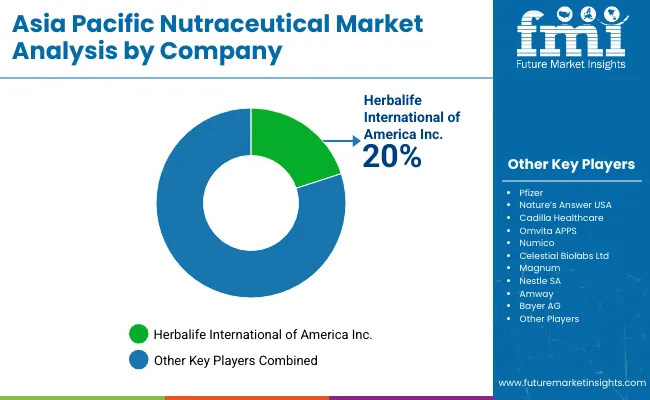
The market is moderately consolidated, with key players competing through advanced extraction technologies, product innovation, and regional market penetration. Leading companies like Ambe Phytoextracts Pvt. Ltd. and Marcor dominate by leveraging large-scale production capacities and diverse nutraceutical formulations targeted primarily at dietary supplements, health foods, and personal care sectors. Their strengths include superior Supercritical CO₂ extraction processes, stringent quality controls, and well-established distribution networks. Regional players focus on sustainable sourcing, product authenticity, and niche market solutions.
Companies such as Douglas Laboratories and Now Foods emphasize cost-effective production and supply chain efficiency, targeting increasing demand for high-purity, gluten-free, and organic products across Asia Pacific and global markets. Barriers to entry remain moderate due to required expertise in extraction, regulatory compliance, and quality assurance. Competitive advantage hinges on innovation in purification techniques, sustainable raw material sourcing, and adapting to diverse consumer preferences and evolving regulations in the market.
| Items | Values |
|---|---|
| Quantitative Units (2025) | USD 103.0 billion |
| Type | Functional Food, Dietary Supplements, Pharmaceuticals, Functional Beverages, and Personal Care |
| Application | General Wellness, Weight Management, Sports & Energy, Beauty and Anti-Aging, and Digestive Health |
| Countries Covered | China, India, Japan, Australia, Singapore, Malaysia, New Zealand, and other Asia Pacific countries |
| Key Companies Profiled | Pfizer, Nature’s Answer USA, Cadilla Healthcare, Omvita APPS, Numico , Celestial Biolabs Ltd, Magnum, Nestle SA, Amway, and Bayer AG. |
| Additional Attributes | Revenue by product type and application, rise of clean-label and plant-based products, expansion of e-commerce, innovation in formulation and extraction technologies, increasing focus on preventive healthcare and wellness trends |
The global Asia Pacific nutraceutical market is estimated to be valued at USD 103.0 billion in 2025.
The market size for the Asia Pacific nutraceutical market is projected to reach USD 202.6 billion by 2035.
The Asia Pacific nutraceutical market is expected to grow at a 7.0% CAGR between 2025 and 2035.
The key product types in Asia Pacific nutraceutical market are functional food, dietary supplements, pharmaceuticals, functional beverages and personal care.
In terms of application, general wellness segment to command 44.2% share in the Asia Pacific nutraceutical market in 2025.






Our Research Products

The "Full Research Suite" delivers actionable market intel, deep dives on markets or technologies, so clients act faster, cut risk, and unlock growth.

The Leaderboard benchmarks and ranks top vendors, classifying them as Established Leaders, Leading Challengers, or Disruptors & Challengers.

Locates where complements amplify value and substitutes erode it, forecasting net impact by horizon

We deliver granular, decision-grade intel: market sizing, 5-year forecasts, pricing, adoption, usage, revenue, and operational KPIs—plus competitor tracking, regulation, and value chains—across 60 countries broadly.

Spot the shifts before they hit your P&L. We track inflection points, adoption curves, pricing moves, and ecosystem plays to show where demand is heading, why it is changing, and what to do next across high-growth markets and disruptive tech

Real-time reads of user behavior. We track shifting priorities, perceptions of today’s and next-gen services, and provider experience, then pace how fast tech moves from trial to adoption, blending buyer, consumer, and channel inputs with social signals (#WhySwitch, #UX).

Partner with our analyst team to build a custom report designed around your business priorities. From analysing market trends to assessing competitors or crafting bespoke datasets, we tailor insights to your needs.
Supplier Intelligence
Discovery & Profiling
Capacity & Footprint
Performance & Risk
Compliance & Governance
Commercial Readiness
Who Supplies Whom
Scorecards & Shortlists
Playbooks & Docs
Category Intelligence
Definition & Scope
Demand & Use Cases
Cost Drivers
Market Structure
Supply Chain Map
Trade & Policy
Operating Norms
Deliverables
Buyer Intelligence
Account Basics
Spend & Scope
Procurement Model
Vendor Requirements
Terms & Policies
Entry Strategy
Pain Points & Triggers
Outputs
Pricing Analysis
Benchmarks
Trends
Should-Cost
Indexation
Landed Cost
Commercial Terms
Deliverables
Brand Analysis
Positioning & Value Prop
Share & Presence
Customer Evidence
Go-to-Market
Digital & Reputation
Compliance & Trust
KPIs & Gaps
Outputs
Full Research Suite comprises of:
Market outlook & trends analysis
Interviews & case studies
Strategic recommendations
Vendor profiles & capabilities analysis
5-year forecasts
8 regions and 60+ country-level data splits
Market segment data splits
12 months of continuous data updates
DELIVERED AS:
PDF EXCEL ONLINE
Asian Sea Bass Market Size and Share Forecast Outlook 2025 to 2035
Asia Pallets Market Size and Share Forecast Outlook 2025 to 2035
Asia Textile Chemicals Market Size and Share Forecast Outlook 2025 to 2035
Asia Neopentyl Glycol (NPG) Market Analysis and Forecast for 2025 to 2035
Asia Pacific Tomato Seed Oil Market Size and Share Forecast Outlook 2025 to 2035
Asia Pacific Loop-mediated Isothermal Amplification (LAMP) Market Size and Share Forecast Outlook 2025 to 2035
Asia Pacific Sachet Packaging Machines Market Size and Share Forecast Outlook 2025 to 2035
Asia Pacific Stick Packaging Machines Market Size and Share Forecast Outlook 2025 to 2035
Asia Pacific and Europe Tarpaulin Sheets Market Size and Share Forecast Outlook 2025 to 2035
Asia Pacific Functional Food Ingredients Market Size and Share Forecast Outlook 2025 to 2035
Asia Pacific Solid State Transformers Market Size and Share Forecast Outlook 2025 to 2035
Asia Pacific Gasoline Injection Technologies Market Size and Share Forecast Outlook 2025 to 2035
Asia Pacific Bentonite Market Size and Share Forecast Outlook 2025 to 2035
Asia Pacific In-Car Entertainment System Market Size and Share Forecast Outlook 2025 to 2035
Asia Pacific Plastic Additives Market Size and Share Forecast Outlook 2025 to 2035
Asia Pacific Waterproofing Chemicals Market Analysis - Size, Share, and Forecast 2025 to 2035
Asia Pacific Wild Rice Market Report – Trends, Growth & Forecast 2025–2035
Asia Pacific Vinegar and Vinaigrette Market Insights – Growth, Demand & Forecast 2025–2035
Asia Pacific Whole Grain and High Fiber Foods Market Outlook – Size, Share & Forecast 2025–2035
Asia Pacific Wood Vinegar Market Analysis – Demand, Size & Forecast 2025–2035

Thank you!
You will receive an email from our Business Development Manager. Please be sure to check your SPAM/JUNK folder too.
Chat With
MaRIA